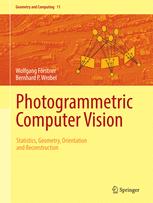

Most ebook files are in PDF format, so you can easily read them using various software such as Foxit Reader or directly on the Google Chrome browser.
Some ebook files are released by publishers in other formats such as .awz, .mobi, .epub, .fb2, etc. You may need to install specific software to read these formats on mobile/PC, such as Calibre.
Please read the tutorial at this link: https://ebookbell.com/faq
We offer FREE conversion to the popular formats you request; however, this may take some time. Therefore, right after payment, please email us, and we will try to provide the service as quickly as possible.
For some exceptional file formats or broken links (if any), please refrain from opening any disputes. Instead, email us first, and we will try to assist within a maximum of 6 hours.
EbookBell Team

4.1
50 reviewsThis textbook offers a statistical view on the geometry of multiple view analysis, required for camera calibration and orientation and for geometric scene reconstruction based on geometric image features. The authors have backgrounds in geodesy and also long experience with development and research in computer vision, and this is the first book to present a joint approach from the converging fields of photogrammetry and computer vision.
Part I of the book provides an introduction to estimation theory, covering aspects such as Bayesian estimation, variance components, and sequential estimation, with a focus on the statistically sound diagnostics of estimation results essential in vision metrology. Part II provides tools for 2D and 3D geometric reasoning using projective geometry. This includes oriented projective geometry and tools for statistically optimal estimation and test of geometric entities and transformations and their relations, tools that are useful also in the context of uncertain reasoning in point clouds. Part III is devoted to modelling the geometry of single and multiple cameras, addressing calibration and orientation, including statistical evaluation and reconstruction of corresponding scene features and surfaces based on geometric image features. The authors provide algorithms for various geometric computation problems in vision metrology, together with mathematical justifications and statistical analysis, thus enabling thorough evaluations. The chapters are self-contained with numerous figures and exercises, and they are supported by an appendix that explains the basic mathematical notation and a detailed index.
The book can serve as the basis for undergraduate and graduate courses in photogrammetry, computer vision, and computer graphics. It is also appropriate for researchers, engineers, and software developers in the photogrammetry and GIS industries, particularly those engaged with statistically based geometric computer vision methods.